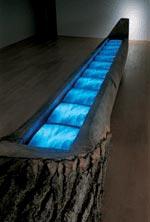Fabrizio Plessi
dal 26/2/2004 al 31/5/2004
Segnalato da
26/2/2004
Fabrizio Plessi
Martin Gropius Bau, Berlin
Dream World Exhibition Place. Fabrizio Plessi has created works throughout the world which address the fate of the great metropolises and cities. Dream and reality, virtuality and materiality meld into magical panoramas in the works designed for such places as New York, Bombay and Haarlem, for Rome and Cairo, for Sarajevo and Lagos. Plessi conjures up his vision of the big cities in dream spaces. These imaginative domains experienced by visitors on their way through the exhibition join together in the end to create the Dream World evoked by the title of the exhibition.

Dream World Exhibition Place
The Exhibition: Fabrizio Plessi has created works throughout the world which address the fate of the great metropolises and cities. Dream and reality, virtuality and materiality meld into magical panoramas in the works designed for such places as New York, Bombay and Haarlem, for Rome and Cairo, for Sarajevo and Lagos. Plessi conjures up his vision of the big cities in dream spaces. These imaginative domains experienced by visitors on their way through the exhibition join together in the end to create the Dream World evoked by the title of the exhibition.
Plessi's journeys and the response provoked by his works inform the world as it really is. The glorious beauty of Roma becomes manifest - the ancient reflex that lies over the installation is breathtaking. But then there is also the emotional shock engendered by the Caryatids of the Poor - a work dedicated to the civilian victims of the massacres in Sarajevo. Towers of empty luggage transform themselves into steles of horror. Or in the words of the artist: 'The house of the future will not be a house. It will be a suitcase, a package, an empty wrapping: shabby belongings dragged from one wretched existence to another. We will all be poor.'
Fabrizio Plessi prepares the realisation of his works by means of thousands of drawings, collages and work sheets made during his travels - and as fundamental documentations of the genesis of these installations, they, too, will be extensively displayed in the Martin-Gropius-Bau.
Dream World - this is the title of the Berlin project. The exhibition compiles all of the available works dedicated to the cities of the world. A total of 16 large interior installations will be on display on the ground floor of the Martin-Gropius-Bau. Further accents of the retrospective will focus on works of his still largely unknown.
La Flotta di Berlino - completed in the fall of 2003 - forms the core of the exhibition. Twelve Venetian barges will be set up in the central hall - a self-supporting construction holds the 12-metre-long boats some 8 metres above ground in fantastic permanent motion.
La Flotta di Berlino pays homage to the German metropolis. The work forms the central part of the exhibition, which has many different aspects and a series of motifs. The leitmotif is unequivocal, however. It is a journey to the dreams, to the visions, to the fears and hopes to which people in the big cities are exposed. This is the medium in which Plessi evokes the history, the greatness and the tragedy of the metropolises.
In Fabrizio Plessi an artist will be presented in Berlin who has explored the electronic medial potential of these years like few others before him, precisely because he combines the high technology of the virtual with materials that carry history within them: found objects, old wood and the debris of marble.
Fabrizio Plessi once compared his work with that of an alchemist:
'My work is that of an unusual alchemist who wants to let the lacklustre and paltry elements of the 'natural' live side by side with the scintillating and lively elements of the 'artistic', like intercommunicating pipelines. The water which has been turned into an electronic fluid by the magic hand of new technology will flow by us forever and ever, sparkling and alive, and move us to wonder and delight like the waters of a Roman fountain in the 17th century. Thus is the artist a being with big antennas that pick up epochal frames of mind and tensions like a seismograph and at the same time anticipate the secret need for beauty and peace felt in a certain way everyone, albeit often in very different ways.'
The Artist: Born in 1940, Fabrizio Plessi, living in Venice, has worked throughout his entire life as an artist on the development of the virtual imagination borne by the electronic technologies. He thus opened new, trend-setting avenues for contemporary art. Today Plessi counts among the pioneers of an artistic method without which present-day art would be inconceivable. Plessi has designed exhibitions for leading museums on all continents - a selection follows: Centre Pompidou (Paris, 1982), Museo Espagnol de Arte Contemporanea (Madrid, 1994), Museum Ludwig (Cologne, 1996), Zentrum für Kunst und Medientechnologie (Karlsruhe, 1997), Fondazione Peggy Guggenheim (Venice, 1997), MOCA (San Diego/La Jolla, 1998), Guggenheim Museum Soho (New York, 1998), Kestner Gesellschaft (Hanover, 1999), IVAM (Valencia, 1999), Museo Correr (Venice, 2001), Scuderia (Rome, 2002).
The Curator: Carl Haenlein (director of the Kestner Gesellschaft until 2002) has worked as curator of exhibitions, among other places, in London, Paris, Vienna, Barcelona, Moscow, St. Petersburg, Munich, Berlin and Venice. He is the author of numerous publications on art and architecture in the 20th century.
The Catalogue: The complete documentation of the exhibition will be published by Chorus Verlag Mainz (c. 240 pp.), edited by Carl Haenlein.
Price in bookshops: euro 38,00, price at the exhibition: euro 25,00
Image: Timaru . L'Enigma degli Addii
© Foto Gunter Lepkowski
Curator Carl Haenlein
Opening hours
daily except Tuesday
10 - 20 hrs
Martin-Gropius-Bau
Niederkirchnerstr. 7 (Corner Stresemannstr.)
Organiser
Berliner Festspiele
Phone: (+49-30) 25486-0
Fax: (+49-30) 25486-107



